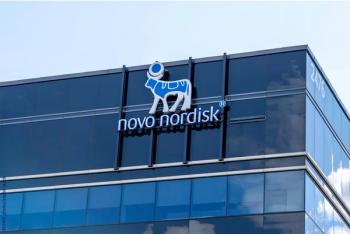
Middle-Aged Man With Newly Detected Atrial Fibrillation
A 56-year-old man with insulin-dependent type 2 diabetes is hospitalized foroperative debridement of an ulcer on his left heel. During the preoperativeevaluation, atrial fibrillation (AF)-with a ventricular rate of 130 beats perminute-is detected.
A 56-year-old man with insulin-dependent type 2 diabetes is hospitalized foroperative debridement of an ulcer on his left heel. During the preoperativeevaluation, atrial fibrillation (AF)--with a ventricular rate of 130 beats perminute--is detected.HISTORYFor many years, this man has had essential hypertension, which is managedwith an angiotensin-converting enzyme inhibitor and a diuretic. Anechocardiogram performed 6 months earlier showed concentric left ventricularhypertrophy, left atrial size of 4.0 cm, and an ejection fraction of 45%. Theresults of the ultrasound study also suggested diastolic dysfunction.PHYSICAL EXAMINATIONThis overweight man is not in acute distress. Blood pressure is170/95 mm Hg. Head, ears, eyes, nose, and throat are unremarkable. Cardiacexamination reveals a leftward, displaced, sustained apical impulse and anirregularly irregular rhythm with a grade II/VI systolic murmur at the base.Bibasilar rales are audible at the lung bases. There is +1 edema of the rightankle and a 5- to 7-cm deep transdermal ulcer on the left heel that is surroundedby significant inflammation and is draining serous purulent material.LABORATORY AND IMAGING RESULTSA complete blood cell count shows leukocytosis with a left shift. Bloodglucose level is 220 mg/dL; other results of the chemistry panel are normal.ECG reveals atrial fibrillation (120 to 130 beats per minute) and left ventricularhypertrophy. A chest radiograph shows cardiomegaly and mild pulmonaryvascular congestion.Middle-Aged Man WithNewly Detected Atrial FibrillationWhich of the following is the optimal strategy for management ofthis patient's AF?A.Cardioversion followed by amiodarone therapy and monthly evaluations.B.Control of the AF rate, accompanied by appropriate antithromboticprophylaxis with warfarin.C.Pharmacologic cardioversion followed by a maintenance regimen ofamiodarone and biweekly evaluations.D.Control of the AF rate, accompanied by an aspirin regimen.CORRECT ANSWER: BAF is the most common sustained cardiac arrhythmiaseen in clinical practice. This serious condition can causepalpitations and exertional dyspnea or even frank congestiveheart failure (CHF) (related to the diminishedeffective cardiac output); it can also lead to stroke andperipheral embolization. Thus, AF is an independent factorthat doubles the risk of death in affected patients.1In recent decades, the recommended initial therapyin patients with recently detected AF focused on therestoration of normal sinus rhythm through cardioversionand a variety of antiarrhythmic drugs.1 The alleged benefitsof such "rhythm control" included fewer symptoms,improved cardiac output and exercise tolerance, lowerstroke incidence,and diminishedneed for anticoagulantprophylaxis.It was alsosuggested thatrhythm controlresulted in improvedsurvival.However,recent majorstudies haveshifted the standardof care towardmore easilyeffected "ratecontrol" therapy.These large trialsshowed that rhythm control strategies had no survivaladvantage compared with rate control strategies.2,3 Somewhatsurprising secondary findings in these studiesincluded:
- Possibly less morbidity in patients who received ratecontrol therapy (associated with a reduced need for anduse of cardiac medications).
- Continued need for anticoagulants in patients who receivedrhythm control therapy, probably because they stillhad random undocumented episodes of AF.
This need for continued anticoagulant prophylaxisnullifies one of the major advantages of rhythm control.Moreover, the cited studies concluded that quality of life,risk of stroke, and overall mortality were equivalent forboth rate control and rhythm control strategies.Thus, neither choice A nor choice C is correct becauseboth represent rhythm control strategies andneither includes anticoagulation. The optimal duration ofanticoagulation required for patients converted to sinusrhythm is not clear and will require further study; however,a regimen that lasts at least 4 to 12 weeks--and likelylonger--is mandatory.
4
Choice D is suboptimal in this setting. Although aspirindoes reduce the stroke incidence in patients with AF,meta-analyses have shown it to be inferior to warfarin.
5
Aspirinmay be adequate in low-risk patients and may be theagent of choice for elderly persons who are unable to takewarfarin. However, this man exhibits evidence of recentCHF and has a systolic blood pressure greater than 160mm Hg; both findings are associated with an increasedrisk of thromboembolism. Thus, aspirin is inadequate forstroke prophylaxis here.Of the options provided for our patient, choice B(rate control and warfarin therapy) is optimal. A variety ofdrugs--β-blockers, calcium channel blockers, and digoxin--can be used to control heart rate. The goal is 80 beatsper minute at rest and less than 110 beats per minute ifand when the patient can perform a walk test. Anticoagulationwith warfarin sufficient to achieve an INR of 2.0 to3.0 is mandatory.
Outcome of this case.
The patient's heart rate wascontrolled with digoxin and metoprolol. He underwentsurgical debridement without complications and was dischargedon his rate control regimen and warfarin.
References:
REFERENCES:
1.
Benjamin EJ, Wolf PA, D’Agostino RB, et al. Impact of atrial fibrillation on therisk of death: the Framingham Heart Study.
Circulation.
1998;98:946-952.
2.
Wyse DG, Waldo AL, DiMarco JP, et al, for the Atrial Fibrillation Follow-upInvestigation of Rhythm Management (AFFIRM) Investigators. A comparison ofrate control and rhythm control in patients with atrial fibrillation.
N Engl J Med.
2002;347:1825-1833.
3.
Van Gelder IC, Hagens VE, Bosker HA, et al, for the Rate Control VersusElectrical Cardioversion for Persistent Atrial Fibrillation Study Group. A comparisonof rate control and rhythm control in patients with recurrent persistentatrial fibrillation.
N Engl J Med.
2002;347:1834-1840.
4.
Falk RH. Management of atrial fibrillation-radical reform or modest modification?
N Engl J Med.
2002;347:1883-1884.
5.
Ezekowitz MD, Levine JA. Preventing stroke in patients with atrial fibrillation.
JAMA.
1999;281:1830-1835.
Newsletter
Enhance your clinical practice with the Patient Care newsletter, offering the latest evidence-based guidelines, diagnostic insights, and treatment strategies for primary care physicians.
















































































































































































































































































